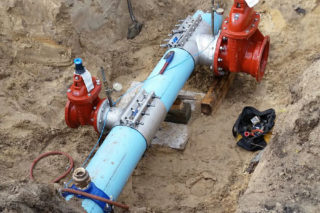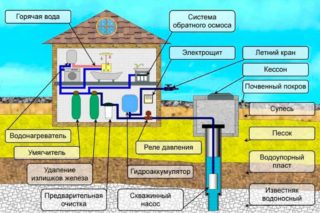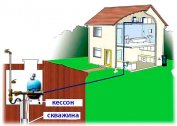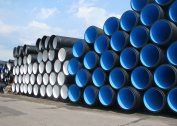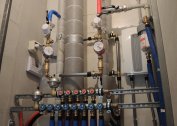It was lucky for private developers who can connect the water supply system of their house to the central water pipe. It will be more difficult for those who organize an autonomous water supply system with water intake from a well or well. The very installation of water supply in a private house does not depend on what type of water intake is used. After all, the pipe layout, the location of consumers, the connection technology, and the principle of operation will be the same.
Water system device
The water supply of a private house consists of two parts: an external wiring from the point of intake to the house, an internal wiring from the point of entry into the house to consumers. Both parts differ quite significantly due to the distribution scheme of plumbing fixtures.
Outer part
The water distribution on the street is carried out strictly according to the project, which is included in the site development plan. Here they try to take into account one important point - from the water intake point to the house, the highway should be drawn with minimal deviations from the straight line.
More recently, there was another important point - the installation of pipes is carried out at a depth below the level of freezing of the soil. Now the building materials market offers a huge selection of heaters, which are used for thermal insulation of water pipes.
There are two categories of external water supply, which differ among themselves by the point of water intake:
- with connection to a centralized water supply system;
- from a well or well using a pump.
In the first case, it is necessary to obtain a permit at Vodokanal, which will indicate the point of connection of water supply. An insert will be made to the water pipe. This is an electrically welded run from a steel pipe to which a plastic pipe will be connected. Not far from the connection point, a well is necessarily constructed in which there will be a water meter and shutoff valves. The latter is used in the repair and replacement of a water meter.
The outer part of the autonomous water supply system is not only a pipe line, but also a hydraulic structure into which the pump will be lowered. Wells are increasingly being used for this, because their depth is greater than that of wells. The lower the aquifer, the cleaner the water in it. The well is drilled with special installations, so the organization of an autonomous water supply system is expensive. The only plus in terms of cost reduction is the lack of a water meter.
Inside
This part of the water supply system is more complicated, because pipes are scattered throughout the premises to consumers. The more consumers, the more powerful the pump should be, the larger the diameters of the pipes used. Therefore, even at the design stage, this factor is taken into account.
Two wiring diagrams are used:
- Sequential. One pipe is put into the house, carried out in all rooms with consumers connected to it. If a private house is small, this is the best option with minimal installation costs.
- Collector. It is used if the house is large, several floors and it has a large number of plumbing. A sequential water supply system does not guarantee the same pressure and performance on all consumers. Therefore, a collector is installed on each floor, from which a separate pipe circuit is laid to each or to a group of consumers.For example, the kitchen has one circuit, the bathroom another and so on.
The collector circuit is more expensive than a sequential one and more complicated in terms of pipe laying. Sometimes it is necessary to lay two or three pipes of different diameters in one shtroba. Therefore, the strobes must be made wide and deep.
Design and implementation of necessary calculations
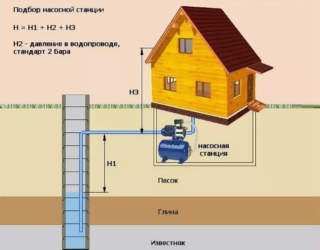 If the pressure in the central water supply does not meet the requirements of the standards, an additional pump will have to be inserted into the inside. This is a small-sized device operating on a voltage of 220 volts.
If the pressure in the central water supply does not meet the requirements of the standards, an additional pump will have to be inserted into the inside. This is a small-sized device operating on a voltage of 220 volts.
The main thing is to choose the right pump unit in terms of fully providing consumers with pressure and volume. For this, it will be necessary to carry out a small calculation - to summarize the throughput (productivity) of all plumbing fixtures.
In an autonomous system, the characteristics of the main pump are primarily calculated. Here the principle of calculation is the same as in the previous case. But you need to consider several other factors:
- at what depth is water withdrawn;
- a surface, submersible or deep pump is used (each has its own water intake methods);
- removal from home.
When designing for an external site, the main straightforwardness. The design of the internal site depends on the location of consumers. The wider the range of plumbing fixtures, the more complex the circuit.
When choosing pipes by diameter, it is necessary to adhere to such recommendations:
- if the length of the section is more than 30 m, it is better to use pipes with a diameter of 32 or 40 mm;
- if the length of the circuit does not exceed 10 m, the optimal choice is a pipe with a diameter of 20 mm;
- connection to some consumers can be carried out with a pipe with a diameter of 15 mm.
Another point that must be taken into account when designing is the introduction of a water supply to a private house. There are two options: through the foundation and through the wall. Typically, openings formed by pipes of a larger diameter than a water pipe are left in one or another structural element of a building.
Installation Steps
Laying of external water pipes in a private house is carried out in trenches that are dug from the well to the house. The bottom is sprinkled with sand, on which pipe products protected by a heater are laid. After the trench is covered with earth.
It is more difficult to carry out an autonomous water supply in the sense that for it it is necessary to build a well and equip it according to all the canons of construction. Usually, a caisson is formed for this, where shutoff valves and a pump are installed. From him they lead a pipe towards the house. The caisson should be closed with a insulated lid.
There is another option: the pump station is mounted inside the house, and a pipe is passed from it to the well or well.
The internal part of the water supply of a private house is not only a distribution of pipes to consumers, but also water treatment, which includes various cleaning devices: filters, softeners, brighteners, etc. Their task is to bring the state of water from the hydraulic structure to “drinking”.
Be sure to install a hydraulic accumulator in the autonomous water supply system. Its task is to create water pressure with the pump turned off. Installation of the accumulator, filters and other elements of water purification is carried out in a special room inside the house. This is usually a basement or one of the offices on the ground floor. All connections are made by American - two-way disconnecting couplings.
There are two ways to install pipes: open and closed. In the first case, the pipes are laid on the walls or on the floor, attaching with plastic clamps (clips). In the second, laying is done in pre-prepared gates in the walls, which after installation are closed with repair mortars. Often, installation is also carried out on the floor under the screed.
How to avoid mistakes during the installation of water supply
Making an autonomous water supply is easy, if you understand the principle of its operation.But often home masters make mistakes that affect the efficiency of the entire system.
- Water pipes and sewers cannot be carried through a foundation into one hole. Between them there should be a horizontal distance of at least 1.5 m.
- Do not bury in the ground or lay in the foundation (wall) connecting fittings. For them it is necessary to make a well.
- Each connection to the plumbing fixtures must be equipped with a service tap, with which water is shut off, if it is necessary to repair or replace the appliance.
An incorrectly selected pump or pipe diameter is a global mistake, on which the efficiency of the water supply depends. Therefore, it is recommended to calculate the water supply system as a whole. It is better to trust this work to professionals, and not to do everything "by eye".
The cost of the plumbing in a private house
Autonomous water supply will be expensive. Its cost will include prices for the pump, pipes, fittings and other equipment, installation work. You will also have to pay for drilling a well. The deeper it is, the more expensive.
It is necessary to obtain permission to drill, put the well on record. If you equip the caisson, it is also a cash expense. But all this is compensated in the future, because there is no need to pay for well water.
Water supply from the main pipe will be cheaper. But bills will come for the fluid consumed. The quality of water from the pipeline is higher than from the well. One coarse filter and a flask kit under the sink - all that is needed to bring the water to "drinking".
